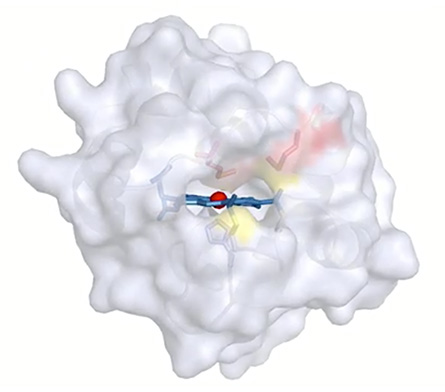
FREAKY FUTURE Is silicon-based life (illustrated above) out there in the universe? The jury is still out — but with a little help from humans, life on Earth might be able to sprinkle a little silicon in with its carbon.
Lei Chen and Yan Liang (BeautyOfScience.com) for Caltech
Carbon and silicon don’t play nice in nature — they link up only in human-made products like paint and pharmaceuticals. But after just three generations of selective breeding, an enzyme can bring the two atoms together, scientists report November 25 in Science. It’s the first time biological tools have bonded carbon to silicon, perhaps opening a way to let living organisms build proteins and other molecules containing silicon.
“What excites me is the demonstration of how rapidly biological systems can innovate,” says study coauthor Frances Arnold, a chemical engineer at Caltech. “They can create new chemistry, new catalytic capabilities out of what’s already there.”
Enzymes are biological catalysts — they kick-start important chemical reactions happening inside living organisms. When the Caltech researchers tested enzymes sitting in their lab fridge, they found that some enzymes that usually did other jobs could also form carbon-silicon bonds. Those enzymes did “very poorly,” says chemical engineer Jennifer Kan of Caltech. “But the potential was there.”
For instance, the enzyme cytochrome c normally shuffles electrons around to help cells make energy. But cytochrome c from hot spring–dwelling Rhodothermus marinus bacteria also had a hidden talent for forging carbon-silicon bonds, the researchers found. To improve on that potential, Kan and her colleagues mutated R. marinus’ DNA and picked out the bacteria making the most catalytically active cytochrome c. Those bacteria were mutated again. After three rounds of mutations, the team was left with a finalist that could jump-start the formation of carbon-silicon bonds more than 15 times better than the top synthetic catalysts currently used for the reaction.
Carbon-silicon bonds are found in hundreds of products, from paints and sealants to drugs and medical implants. So the enzyme-based catalyst might someday offer a more sustainable alternative to the expensive metal catalysts that are now used to create these compounds.
“You can boil this puppy. It’s super stable because it comes from an organism that lives in these hot springs,” says Arnold.
The enzyme might need a little additional tweaking before being used commercially as a catalyst. “I would say the caveat is the particular carbon-silicon bond being made,” says John Hartwig, an organic chemist at the University of California, Berkeley, who wasn’t involved in the study. The specific silicon-containing compounds made by the enzyme aren’t ones widely produced by chemical companies — although the compounds could be intermediate steps in other reactions.
Likewise, humans aren’t on track to become silicon-based cyborgs anytime soon. But the study does open up a way to let simple organisms like bacteria use silicon as a building block, which could change their behavior in ways scientists have never been able to study before. “We can think about the effects of having silicon there,” says Arnold. “In the past, that’s been hard to do.”







